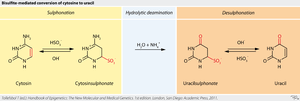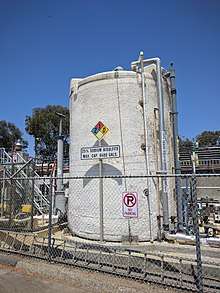Sodium bisulfite
 | |
 | |
| Names | |
|---|---|
| IUPAC name
Sodium hydrogen sulfite | |
| Other names
E222 | |
| Identifiers | |
3D model (JSmol) |
|
| ChEBI | |
| ChEMBL | |
| ChemSpider | |
| ECHA InfoCard | 100.028.680 |
| E number | E222 (preservatives) |
PubChem CID |
|
| RTECS number | VZ2000000 |
| |
| |
| Properties | |
| NaHSO3 | |
| Molar mass | 104.061 g/mol |
| Appearance | White solid |
| Odor | slight sulfurous odor |
| Density | 1.48 g/cm3 |
| Melting point | 150 °C (302 °F; 423 K) |
| Boiling point | 315 °C (599 °F; 588 K) |
| 42 g/100 mL | |
Refractive index (nD) |
1.526 |
| Hazards | |
EU classification (DSD) (outdated) |
Harmful (Xn) |
| R-phrases (outdated) | R22 R31 |
| S-phrases (outdated) | (S2), S25, S46 |
| NFPA 704 | |
| Flash point | Non-flammable |
| Lethal dose or concentration (LD, LC): | |
LD50 (median dose) |
2340 mg/kg (oral, rat)[1] |
| US health exposure limits (NIOSH): | |
PEL (Permissible) |
none[2] |
REL (Recommended) |
TWA 5 mg/m3[2] |
IDLH (Immediate danger) |
N.D.[2] |
| Related compounds | |
Other anions |
Sodium sulfite Sodium metabisulfite |
Other cations |
Potassium bisulfite |
Except where otherwise noted, data are given for materials in their standard state (at 25 °C [77 °F], 100 kPa). | |
| Infobox references | |
Sodium bisulfite (or sodium bisulphite) (sodium hydrogen sulfite) is a chemical compound with the chemical formula NaHSO3. Sodium bisulfite is a food additive with E number E222. This salt of bisulfite can be prepared by bubbling sulfur dioxide in a solution of sodium carbonate in water. Sodium bisulfite in contact with chlorine bleach (aqueous solution of sodium hypochlorite) will generate heat and form sodium bisulfate and sodium chloride.
Synthesis
Sodium bisulfite can be prepared by bubbling excess sulfur dioxide through a solution of suitable base, such as sodium hydroxide or sodium bicarbonate.
- SO2 + NaOH → NaHSO3
- SO2 + NaHCO3 → NaHSO3 + CO2
Properties
Sodium bisulfite is a weakly acidic species with a pKa of 6.97. Its conjugate base is the sulfite ion, SO32−:
- HSO3− ↔ SO32− + H+
The theoretical fully protonated species is sulfurous acid (H2SO3); however this does not exist in solution and treatment of sodium bisulfite with acids will result in decomposition with telltale effervescence of sulfur dioxide, e.g.,
- NaHSO3 + HCl → NaCl + H2O + SO2
Reactions
In organic chemistry sodium bisulfite has several applications. It forms a bisulfite adduct with aldehyde groups and with certain cyclic ketones to give a sulfonic acid.[3]
This reaction is useful for purification procedures. Contaminated aldehydes in a solution precipitate as the bisulfite adduct which can be isolated by filtration. The reverse reaction takes place in presence of a base such as sodium bicarbonate or sodium hydroxide and the bisulfite is liberated as sulfur dioxide.[4]
Examples of such procedures are described for benzaldehyde,[5] 2-tetralone,[6] citral,[7] the ethyl ester of pyruvic acid[8] and glyoxal.[9] In the ring-expansion reaction of cyclohexanone with diazald, the bisulfite reaction is reported to be able to differentiate between the primary reaction product cycloheptanone and the main contaminant cyclooctanone.[10]
The other main use of sodium bisulfite is as a mild reducing agent in organic synthesis in particular in purification procedures. It can efficiently remove traces or excess amounts of chlorine, bromine, iodine, hypochlorite salts, osmate esters, chromium trioxide and potassium permanganate.
A third use of sodium bisulfite is as a decoloration agent in purification procedures because it can reduce strongly coloured oxidizing agents, conjugated alkenes and carbonyl compounds.
Sodium bisulfite is also the key ingredient in the Bucherer reaction. In this reaction an aromatic hydroxyl group is replaced by an aromatic amine group and vice versa because it is a reversible reaction. The first step in this reaction is an addition reaction of sodium bisulfite to an aromatic double bond. The Bucherer carbazole synthesis is a related organic reaction that uses sodium bisulfite as a reagent.
Uses in food and FDA ban
While the related compound, sodium metabisulfite, is used in almost all commercial wines to prevent oxidation and preserve flavor, sodium bisulfite is sold by some home winemaking suppliers for the same purpose.[11] In fruit canning, sodium bisulfite is used to prevent browning (caused by oxidation) and to kill microbes.
In the case of wine making, sodium bisulfite releases sulfur dioxide gas when added to water or products containing water. The sulfur dioxide kills yeasts, fungi, and bacteria in the grape juice before fermentation. When the sulfur dioxide levels have subsided (about 24 hours), fresh yeast is added for fermentation.
It is later added to bottled wine to prevent the formation of vinegar if bacteria are present, and to protect the color, aroma and flavor of the wine from oxidation, which causes browning and other chemical changes. The sulfur dioxide quickly reacts with oxidation by-products and prevents them from causing further deterioration.
Sodium bisulfite is also added to leafy green vegetables in salad bars and elsewhere, to preserve apparent freshness, under names like LeafGreen. The concentration is sometimes high enough to cause allergic reactions.[12]
On July 8, 1986, sodium bisulfite was banned from use by the FDA on fresh fruits and vegetables in the United States following the deaths of 13 people and many illnesses, mainly among asthmatics.[13]
Bisulfite DNA sequencing

Sodium bisulfite is used in the analysis of the methylation status of cytosines in DNA.
In this technique, sodium bisulfite deaminates cytosine into uracil, but does not affect 5-methylcytosine, a methylated form of cytosine with a methyl group attached to carbon 5.
When the bisulfite-treated DNA is amplified via polymerase chain reaction, the uracil is amplified as thymine and the methylated cytosines are amplified as cytosine. DNA sequencing techniques are then used to read the sequence of the bisulfite-treated DNA. Those cytosines that are read as cytosines after sequencing represent methylated cytosines, while those that are read as thymines represent unmethylated cytosines in the genomic DNA.[14]
Industrial uses

Sodium bisulfite is a common reducing agent in the chemical industry, as it readily reacts with dissolved oxygen:
- 2 NaHSO3 + O2 → 2 NaHSO4
It is usually added to large piping systems to prevent oxidative corrosion. In biochemical engineering applications, it is helpful to maintain anaerobic conditions within a reactor. Sodium bisulfite should not be confused with sodium bisulfate which is used as a pH lowering chemical for swimming pools.
In drinking water treatment, sodium bisulfite is often added after super chlorination, to reduce the residual chlorine before discharging to the service reservoir.
In wastewater treatment, sodium bisulfite is often added following disinfection with chlorine prior to discharging the effluent to the receiving water. Residual chlorine can have a negative impact on aquatic life.
In steam boilers, sodium bisulfite has been a reliable oxygen scavenger in boiler feedwater for approximately 60 years. This compound is characterized as having fast reaction times, low use-cost, years of proven performance, availability. Sodium bisulfite when used in steam boilers has FDA and USDA approvals.[15]
See also
References
- ↑ http://chem.sis.nlm.nih.gov/chemidplus/rn/7646-93-7
- 1 2 3 "NIOSH Pocket Guide to Chemical Hazards #0561". National Institute for Occupational Safety and Health (NIOSH).
- ↑ Steven D. Young, Charles T. Buse, and Clayton H. Heathcock (1990). "2-Methyl-2-(Trimethylsiloxy)pentan-3-one". Organic Syntheses. ; Collective Volume, 7, p. 381
- ↑ S. A. Buntin and Richard F. Heck (1990). "2-Methyl-3-phenylpropanal". Organic Syntheses. ; Collective Volume, 7, p. 361
- ↑ Harold M. Taylor and Charles R. Hauser (1973). "α-(N,N-Dimethylamino)phenylacetonitrile". Organic Syntheses. ; Collective Volume, 5, p. 437
- ↑ M. D. Soffer, M. P. Bellis, Hilda E. Gellerson, and Roberta A. Stewart (1963). "β-Tetralone". Organic Syntheses. ; Collective Volume, 4, p. 903
- ↑ Alfred Russell and R. L. Kenyon (1955). "Pseudoionone". Organic Syntheses. ; Collective Volume, 3, p. 747
- ↑ J. W. Cornforth (1963). "Ethyl Pyruvate". Organic Syntheses. ; Collective Volume, 4, p. 467
- ↑ Anthony R. Ronzio and T. D. Waugh (1955). "Glyoxal Bisulfite". Organic Syntheses. ; Collective Volume, 3, p. 438
- ↑ Hyp J. Dauben, Jr., Howard J. Ringold, Robert H. Wade, David L. Pearson, and Arthur G. Anderson, Jr. "Cycloheptanone". Organic Syntheses. ; Collective Volume, 4, p. 221
- ↑ The Many Uses Of Sodium Bisulfite
- ↑ Albertson, Timothy Eugene (2006). Bronchial Asthma: A Guide for Practical Understanding and Treatment (Current Clinical Practice) (fifth ed.). Totowa, NJ: Humana Press. pp. 260–266. ISBN 1-58829-872-8. Retrieved 2011-11-11.
- ↑ Molotsky, Irvin (July 9, 1986). "U.S. ISSUES BAN ON SULFITES' USE IN CERTAIN FOODS". The New York Times. Retrieved 2017-10-09.
- ↑ Frommer, M.; McDonald, L. E.; Millar, D. S.; Collis, C.M.; Watt, F.; Grigg, G.W.; Molloy P.L.; Paul, C.L. (1992). "A genomic sequencing protocol that yields a positive display of 5-methylcytosine residues in individual DNA strands" (free full text). PNAS. 89 (5): 1827–31. doi:10.1073/pnas.89.5.1827. PMC 48546. PMID 1542678.
- ↑ Wolfe, Thomas W. "Operation of Deaerators to Increase Boiler System Reliability" (PDF). The Analyst: Voice of the Water Treatment Industry. Association of Water Technologies. Retrieved 2017-08-03.

